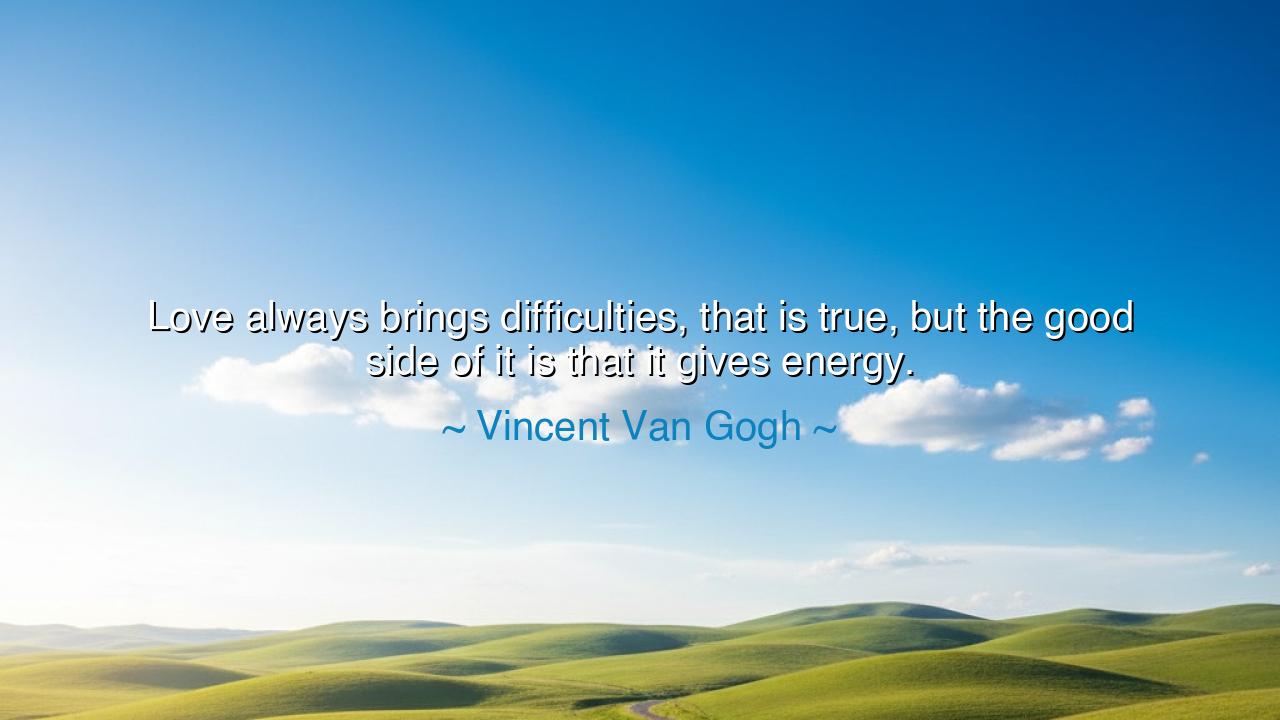
Love always brings difficulties, that is true, but the good side
Love always brings difficulties, that is true, but the good side of it is that it gives energy.






“Love always brings difficulties, that is true, but the good side of it is that it gives energy.” Thus spoke Vincent van Gogh, the tormented artist of light and shadow, whose soul was aflame with both suffering and beauty. In these simple yet profound words lies the eternal paradox of love—that it wounds and heals, burdens and strengthens, breaks and restores. Van Gogh knew that love is not the calm sea of comfort, but the restless tide that moves the soul toward creation, growth, and truth. It is a force that tests the heart, yet also energizes it, awakening in us the divine power to endure, to give, and to create beyond despair.
In this saying, Van Gogh does not speak of love as mere romance, but as the vital spark of existence itself. He understood that to love—whether a person, an idea, or one’s art—is to open oneself to pain. The more deeply one loves, the more deeply one feels the ache of imperfection, distance, and loss. Yet he also knew that the very same love that causes sorrow also fuels creation. The heart that suffers for love beats stronger, for it beats with meaning. Love gives energy because it anchors life in purpose; it turns struggle into devotion, and loneliness into longing that moves the world.
Van Gogh’s own life was a testament to this truth. He loved fiercely—his family, his faith, his fellow men, and above all, his art. Yet that love brought him no peace. He battled poverty, rejection, and despair. His relationships often crumbled under the weight of his intensity. But from his difficulties, he drew energy. The fire that consumed him also illuminated his canvas. In his final years, when loneliness pressed upon him like a storm, he painted fields of gold, swirling skies, and sunflowers that seemed to worship light itself. His pain became power, his sorrow became color. The love that broke his heart also gave birth to beauty that would outlast his name.
The origin of this quote can be traced to Van Gogh’s letters to his brother, Theo, his constant friend and supporter. In those letters, he revealed the raw landscape of his inner world—the struggles of the spirit and the hope that art could heal it. When he wrote that love gives energy, he was speaking as one who had learned to transform suffering into strength. To him, the act of creation was an act of love: a way of saying to the world, “Though I am wounded, I still give.” It was through love that he found the will to rise each morning, take up his brush, and bring color to a life that so often seemed grey.
This quote, then, carries a timeless lesson: that love’s difficulties are not curses, but catalysts. To love is to step willingly into vulnerability, to accept that pain is the price of meaning. Many flee from love’s trials, seeking safety in indifference—but safety is the death of the soul. Only love, with its trials and triumphs, keeps the heart alive. It is love that drives the mother to endure labor for her child, the artist to work through the night for his vision, the believer to hope though the world despairs. Love does not remove hardship—it transforms it into motion, into energy that carries us forward.
Consider also the story of Helen Keller and her teacher Anne Sullivan. Their bond was not born of ease, but of struggle. Anne’s love for Helen was patient and fierce, forged through frustration and tears. Yet from that struggle came light—a child once imprisoned in silence learned to speak to the world. The difficulties of their love became the source of their strength. So too in our own lives: when love demands much of us, it also grants us the strength to give much in return.
So, my child of the living heart, remember this: do not flee from love because it is hard. Embrace its trials, for they are the forge of your becoming. Let your love—whether for people, for your work, or for the world—burn brightly, even when it hurts. Turn pain into purpose, and let compassion become your fuel. When you give of yourself in love, you will find, as Van Gogh did, that the soul never truly tires. For though love brings difficulties, it is also the source of life’s divine energy—the fire that keeps us creating, believing, and becoming until our final breath.






AAdministratorAdministrator
Welcome, honored guests. Please leave a comment, we will respond soon